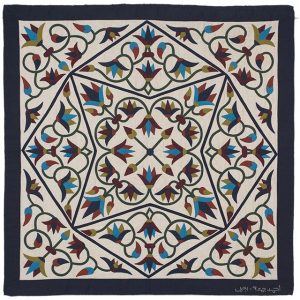Starting with the ancient Egyptians, the use of applique can be traced back probably much older than 3300 years. Ancient Egyptian pharaoh, Tutankhamun‘s tomb, who died in c.1323 BC. cite some of the oldest examples of Ancient Egypt Appliqué work. Appliqué is the method of fastening a decoration to a larger piece of fabric. The term applique is derived from the French word “applique” and the latin word “applicare” which means to join or attach. While applique’s early use can be said to most likely to strengthen worn areas and serve as a patch over holes.

However, appliqué developed into a creative art form that was used by many cultures over many centuries. This traditional craft can be found on garments and cloth patterns in every part of the world. During the middle Ages, elaborate appliqué was used on ceremonial clothing and heraldic and ecclesiastical banners.
Appliqué art is the art form was originally practiced by Arab nomads that used the traditional craft to adorn the interior of their tents. This ancient craft was known as “Khayamiya” where Khaya means “tent” in Arabic. Huge tent pavilions were designed with the applique cloth patterns. With the passage of time, the importance of tents started to decline and this traditional craft cannot be utilized the way it was used before.
Ancient Egypt Applique Technique
Appliqué is a needlework technique that creates a decorative effect and a unique design on the cloth. It is a method whereby a piece of cloth or other material is laid on top of another on a larger piece stitching both fabrics together. This combined piece of cloth may in its turn be stitched on top of another.

In this art form, a number of patches of different color fabrics were sewed upon another fabric that had a solid background color. The patchwork would be composed in such a manner so as to create a decorative unique pattern, design or scenery.
In another form of applique, different types of braid were used to decorate objects, usually garments. If the braid had small fringes along its edges, the braid was placed along the outer edge of a piece of cloth and sewed. But when there were no fringes, it was usually either sewn across the cloth or down the edges.
The opposite of the traditional appliqué craft is reverse appliqué form. In this, all of the fabrics that are going to be in the design are layered and the pattern is formed by cutting down to expose the layers. The final part is that the raw edges are turned under and sewn to the next fabric.
Appliqué is a traditional craft and a part of the decoration on national (festival) costumes (eighteenth and nineteenth centuries) and ethnic folk garments and dresses. Several appliquéd garments and ethnic wear are associated with the twentieth century.